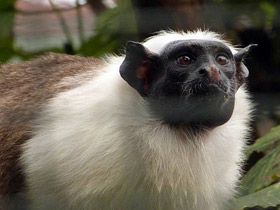The pied tamarin(Saguinus bicolor), the Brazilian bare-faced tamarin
 The pied tamarin (Saguinus bicolor) is included in the IUCN Red List as a "threatened species"
The pied tamarin (Saguinus bicolor) is included in the IUCN Red List as a "threatened species"
The pied tamarin (Saguinus bicolor), sometimes referred to as the Brazilian bare-faced tamarin, is a Critically Endangered primate species found in a restricted area of the Brazilian Amazon Rainforest. It was named the mascot of Manaus, Brazil in 2005. The species is endangered due to the increasing size of the city of Manaus which is encroaching on their native habitat.
Habitat
Saguinus bicolor is an endangered species of platyrrhine primate. Saguinus bicolor inhabits the Brazilian rainforest, occupying a small range north of the Amazon River. It prefers to settle in secondary forests, swamps and forest edges. Saguinus bicolor spends most of its time in the treetops, at a height of 10 to 12 metres.
Appearance
The body length of this primate ranges from 208 to 283 mm, the tail length from 335 to 420 mm, and the average weight is 430 g. Also known as "pegio", Saguinus bicolor gets its name from the combination of its black, naked face and ears, which contrast with the alternating colours of its fur, such as brown, black or silver, which varies from subspecies to subspecies. Sexual dimorphism is not pronounced in Saguinus bicolor.
Reproduction
Saguinus bicolor probably gives birth throughout the year, but the greatest number of young are born between March and May. As a rule, only the dominant female of each social group can breed. The other females do not ovulate as long as the pheromones of the dominant female are present. Gestation lasts about 140-150 days in these Saguinus bicolor females; in 80% of cases females give birth to twins and their weight ranges from 14.1 to 23.5% of the maternal weight.
The young are born fully pubescent but defenceless, but are soon able to cling tightly to their parents' fur. They begin to explore the outside world on their own at 20 days of age, but continue to ride their parents until they are about 6-7 weeks old.
As with other species of Callitrichidae, the male takes care of the young for the most part. Non-breeding individuals of Saguinus bicolor, which are members of the social group, also participate in the care of the young, although less frequently than the parents. This behaviour - assisting in the care and education of their young - provides them with valuable experience in caring for their young, as well as ensuring the survival of their younger siblings or other close relatives.
Nutrition
Saguinus bicolor feeds on a variety of foods. Fruits and flowers make up 96.1% of the plant components of the diet, along with tree sap. A small proportion of the diet consists of animal foods, including insects, and plant resins (gums), which are consumed mainly during the dry season. When hunting large insects, Saguinus bicolor usually approaches them with caution. Saguinus bicolor also feeds on leaves, seeds, grains and nuts, fruits, flowers, sap or other liquids excreted by plants.
Endangerment
The tamarins live nearby the rapidly growing city of Manaus, and as the city's area increases in size, the tamarins habitat disappears. When they can avoid the busy automobile traffic and the electric power lines, the pied tamarin reside in the small sections of forest that still remain in Manaus.
Environmental Impact
Being an omnivore, the pied tamarins diet consists highly of plants. They pick up plant seeds when they eat and disperse them around their environment, thus bolstering their ecosystem. They also dine on small animals, which keeps the insect and amphibian populations in check. With the declining tamarin population, the issue becomes bigger than just the primates, but now turns into an ecosystem issue. There is no way to know for certain how the loss of the pied tamarin population will affect the Amazonian ecosystem, but there almost undoubtedly will be effects.
Saguinus bicolor on the Red List
Saguinus bicolor is a rare animal listed as endangered on the IUCN Red List.














































